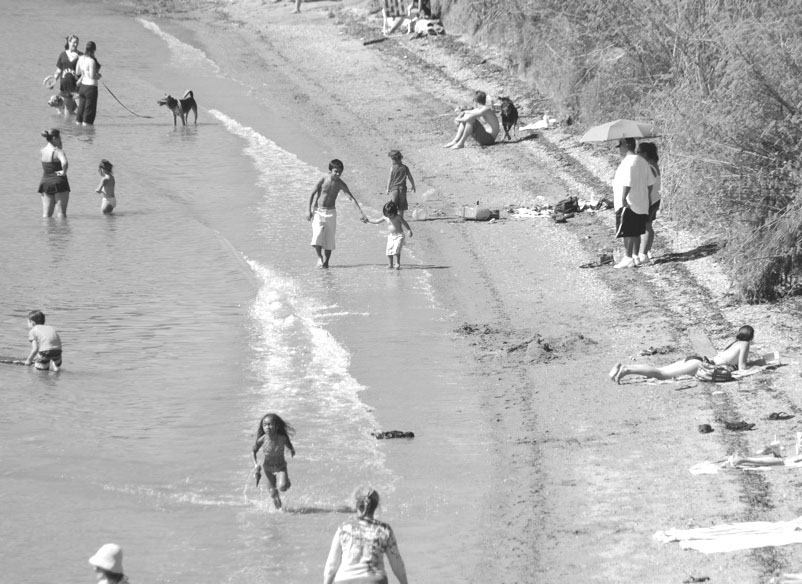If “Some Like It Hot,” as the old Billy Wilder movie title says, Tuesday and Wednesday will make them very happy, indeed.
For others, it’s a time to be smart about dealing with the heat — or avoiding it — as the mercury nears 92 Tuesday and goes even higher Wednesday.
The National Weather Service expects Tuesday to be sunny, with southwest breezes that range from 5-11 mph before switching to the northeast. Skies will remain clear, and southwest winds will be about 7 p.m. throughout the night, when temperatures drop to 64 degrees.
Tuesday also is a “Spare the Air” day, according to the Bay Area Air Quality Management District.
A high concentration of ground-level ozone pollution prompted the alert, which recommends residents reduce their use of motor vehicles and walk or use bicycles, public transit or carpools, or work from home.
In addition, the Air District asks residents to avoid using gasoline-powered lawn mowers and leaf blowers, reduce their home energy consumption, avoid using lighter fluid on their barbecues and refrain from using aerosol spray cleaners, paints and hairspray.
Those planning vigorous exercise should do so only in the morning, when ozone levels are lower, because high levels of ozone pollution are harmful, “particularly … for young children, seniors and those with respiratory and heart conditions,” according to a statement released by the district.
Wednesday will be sunny with calm winds, with temperatures expected near 95 degrees, the Weather Service has predicted. Overnight, the temperatures should cool to about 63.
Thursday’s high should be about 88, with an overnight low of 56, and by Friday the highs will drop to 78 with sunny skies.
Highs of low- to mid-70s and lows in the mid-50s will remain through Sunday, according to the Weather Service.
On hot days, Benicians can find relief at Benicia Public Library, 150 East L St., and the Benicia Community Center, 370 East L St., the city’s designated cooling sites.
In Benicia, the library’s hours are 10 a.m. to 9 p.m. Monday through Thursday and noon to 6 p.m. Friday through Sunday.
People and animals shouldn’t be left in parked vehicles, which can heat up to harmful and fatal temperatures rapidly, even when windows are left cracked open, according to information provided by Benicia Police Department.
Public and private employees are governed by the California Division of Occupational Safety and Health, which publishes heat illness prevention training. But its tips apply to anyone working or playing outdoors on hot days.
Benicia Fire Department has the same advice, not only for its own department employees but for residents as well.
Heat is a hazard when it prevents a body from getting rid of excess heat fast enough to regulate the body’s temperature.
Human bodies can cool through sweating, but CalOSHA noted that it works only when the humidity level is low enough and if lost fluids and salts are replaced.
A person’s body stores heat when it can’t get rid of it fast enough. Heat stress occurs when the person’s core temperature rises and heart rate increases, resulting in trouble concentrating or disorientation, irritability or nausea. Eventually, the person may faint and can die if not cooled down.
Heat rash, also called prickly heat, is a milder heat-related illness caused when sweat doesn’t evaporate and resulting in clusters of red bumps on the skin. The affected area should be kept dry, and the person should try to work in a cooler, less-humid area.
Heat cramps, usually in the abdomen, arms or legs, are caused by a loss of body salts and fluid during sweating, and usually involve tired muscles that can cramp either during or after activity.
The person suffering heat cramps should find a shady, cool area and drink water, resting a few hours before returning to work. If the cramps don’t stop, the person should seek medical attention.
Signs of heat exhaustion, also caused by loss of water and salt, are headache, nausea, dizziness, weakness, irritability, thirst and heavy sweating. The person should stop work, sit or lie down in a cool, shady area and drink cool water, and use cold compresses or ice packs to cool down. The person should be taken to a clinic or emergency room for evaluation if symptoms don’t subside within an hour.
The most serious form of heat-related illnesses is heat stroke, caused when the body no longer can regulate its temperature. Sweating stops. The person becomes confused and may lose consciousnesses and undergo seizures.
Heat stroke is an emergency, and medical help should be called. Until an emergency responder arrives, the person should be kept in a cool, shady area, with clothing loosened and outer layers removed. Someone should fan the air around the person.
First aid also involves placing cold packs in the armpits, wetting the person with cool water, ice packs or compresses, and providing water. Someone should stay with the person until help arrives.
But prevention is a better option, according to CalOSHA and Benicia Fire Department.
Under CalOSHA rules, employees working in the heat should be able to drink at least a quart of potable water each shift, and are advised to drink a cup of water every 15-20 minutes even if they think they’re not thirsty. Alcohol and coffee should be avoided.
Those working or playing outside are advised to drink 24 ounces of water two hours before engaging in physical exercise or labor, and to eat fruit and vegetables to replace nutrients.
They should wear loose-fitting, lightweight and light-colored cotton clothes, a wide-brimmed hat or cap, and a bandana.
Those with diabetes, taking certain medications or who are on a low-salt diet need to take additional precautions, because that makes them more vulnerable to the effects of heat. Co-workers or teammates should be monitored for signs of heat stress, the Benicia Fire Department advisory noted, and relief workers should be available.







Leave a Reply